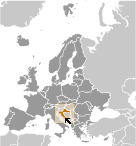World Atlas: Croatia. On this page you can see the map, country flag and many detailed information about the people, history and economy of Croatia.

Here you can find online selected information about the geography, inhabitants, government, economy and history of Croatia. Included are selected statistics, an overview map and the detailed map of Croatia. But let's start with the flag of Croatia here:
Croatia - Overview:
What you should know about Croatia? Let's start with this: The lands that today comprise Croatia were part of the Austro-Hungarian Empire until the close of World War I. In 1918, the Croats, Serbs, and Slovenes formed a kingdom known after 1929 as Yugoslavia. Following World War II, Yugoslavia became a federal independent communist state under the strong hand of Marshal Josip Broz, aka TITO. Although Croatia declared its independence from Yugoslavia in 1991, it took four years of sporadic, but often bitter, fighting before occupying Serb armies were mostly cleared from Croatian lands, along with a majority of Croatia's ethnic Serb population. Under UN supervision, the last Serb-held enclave in eastern Slavonia was returned to Croatia in 1998. The country joined NATO in April 2009 and the EU in July 2013.
Geography of Croatia
 Where on the globe is Croatia? The location of this country is Southeastern Europe, bordering the Adriatic Sea, between Bosnia and Herzegovina and Slovenia. Total area of Croatia is 56,594 sq km, of which 55,974 sq km is land. So this is not a large country. How could we describe the terrain of the country? This way: geographically diverse; flat plains along Hungarian border, low mountains and highlands near Adriatic coastline and islands. The lowest point of Croatia is Adriatic Sea 0 m, the highest point Dinara 1,831 m. And the climate is Mediterranean and continental; continental climate predominant with hot summers and cold winters; mild winters, dry summers along coast.
Where on the globe is Croatia? The location of this country is Southeastern Europe, bordering the Adriatic Sea, between Bosnia and Herzegovina and Slovenia. Total area of Croatia is 56,594 sq km, of which 55,974 sq km is land. So this is not a large country. How could we describe the terrain of the country? This way: geographically diverse; flat plains along Hungarian border, low mountains and highlands near Adriatic coastline and islands. The lowest point of Croatia is Adriatic Sea 0 m, the highest point Dinara 1,831 m. And the climate is Mediterranean and continental; continental climate predominant with hot summers and cold winters; mild winters, dry summers along coast.
Inhabitants of Croatia
Let's take a look how many people live in Croatia. The number is: 4,292,095 (July 2017 est.). So this is not very populous country. Who lives here? Croat 90.4%, Serb 4.4%, other 4.4% (including Bosniak, Hungarian, Slovene, Czech, and Romani), unspecified 0.8% (2011 est.). What are the languages in Croatia? Croatian (official) 95.6%, Serbian 1.2%, other 3% (including Hungarian, Czech, Slovak, and Albanian), unspecified 0.2% (2011 est.). And the religions: Roman Catholic 86.3%, Orthodox 4.4%, Muslim 1.5%, other 1.5%, unspecified 2.5%, not religious or atheist 3.8% (2011 est.). How old are the people in average? 43 years. We have to add that this number is the median - so one half of the people is older than this, one half is younger. And what is their life expectancy (at birth)? This: 76.1 years. Where the people live in Croatia? Here: more of the population lives in the northern half of the country, with approximately a quarter of the populace residing in and around the capital of Zagreb; many of the islands are sparsely populated. The major urban areas of Croatia are: Zagreb (capital) 687,000 (2015).
Government and Economy of Croatia
The capital of Croatia is Zagre and the government type parliamentary republic. Let's take a look at the administrative divisions - 20 counties (zupanije, zupanija - singular) and 1 city (grad - singular) with special county status; Bjelovarsko-Bilogorska(Bjelovar-Bilogora), Brodsko-Posavska (Brod-Posavina), Dubrovacko-Neretvanska (Dubrovnik-Neretva), Istarska (Istria), Karlovacka (Karlovac), Koprivnicko-Krizevacka (Koprivnica-Krizevci), Krapinsko-Zagorska (Krapina-Zagorje), Licko-Senjska (Lika-Senj), Medimurska (Medimurje), Osjecko-Baranjska (Osijek-Baranja), Pozesko-Slavonska (Pozega-Slavonia), Primorsko-Goranska (Primorje-Gorski Kotar), Sibensko-Kninska (Sibenik-Knin), Sisacko-Moslavacka (Sisak-Moslavina), Splitsko-Dalmatinska (Split-Dalmatia), Varazdinska (Varazdin), Viroviticko-Podravska (Virovitica-Podravina), Vukovarsko-Srijemska (Vukovar-Syrmia), Zadarska (Zadar), Zagreb, Zagrebacka (Zagreb county). Regarding the economy of Croatia, important industrial products are chemicals and plastics, machine tools, fabricated metal, electronics, pig iron and rolled steel products, aluminum, paper, wood products, construction materials, textiles, shipbuilding, petroleum and petroleum refining, food and beverages, tourism. Important agricultural products are arable crops (wheat, corn, barley, sugar beet, sunflower, rapeseed, alfalfa, clover); vegetables (potatoes, cabbage, onion, tomato, pepper); fruits (apples, plum, mandarins, olives), grapes for wine; livestock (cattle, cows, pigs); dairy products. The most important export commodities are transport equipment, machinery, textiles, chemicals, foodstuffs, fuels and the most important export partners are Italy 13.5%, Slovenia 12.3%, Germany 11.6%, Bosnia and Herzegovina 9.2%, Austria 6.3%, Serbia 4.2% (2016). The most important import commodities are machinery, transport and electrical equipment; chemicals, fuels and lubricants; foodstuffs and the most important import partners are Germany 16.1%, Italy 12.6%, Slovenia 10.9%, Austria 7.9%, Hungary 7.1% (2016). How rich is Croatia and how rich are people in this country? The most important number here is GDP per capita (PPP): $24,100 (2017 est.). This means the living standards are good here. Let's add that this means Gross Domestic Product per person, which is recalculated with respect to the relative cost of local goods and services. And one more important number - population below poverty line: 19.5% (2014 est.).